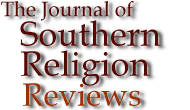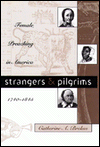


Brekus, Catherine A. Strangers and Pilgrims: Female Preaching in America, 1740-1845. (Chapel Hill and London: The University of North Carolina Press, 1998), pp. x, 466.
![]()
![]()
![]()
The few women currently serving in the Christian pastorate often face an uphill battle in their efforts to garner respect and cooperation from male churchgoers. These women experience difficulties in transcending what church historian Susie Stanley defines as the “stained-glass ceiling,” or barriers to female advancement even in denominations with a long tradition of women's ordination. Few historians recognize that a significant number women took up the cross as preachers more than a century before the Civil War. Consequently, few contemporary women ministers know that they hail from a long line of women who willingly sacrificed emotional and financial security and respectability to “labor in the harvest.” Moreover, because denominations that once eagerly ordained women eventually shunned them and chose to ignore their contributions, each generation of women preachers has been obligated to defend its right to preach. Through Catherine Brekus’ meticulous research and analysis of church records, memoirs, religious periodicals, tracts, and sermons of both men and women ministers, the stories of one hundred women who heeded the call to preach the gospel during the eighteenth and nineteenth centuries have been resurrected. Brekus effectively demonstrates that these women's determination to heed God’s call helped swell the membership roles of churches across the New Republic and established a precedent for women’s right to occupy the pulpit.
| "Brekus’ use of a wealth of primary sources and her extraordinary analysis of the intellectual, political, cultural, and social history and their influence upon gender roles in the church weaves a fascinating narrative that should spur scholars to do further research on the role of women in the church." | |
The Second Great Awakening saw a re-emergence of women’s leadership in new, dissenting sects that challenged the prevailing attitude of Calvinism. As the republic matured, America began to identify women as “saviors of the nation,” able to cure an increasingly market-driven society of its spiritual, economic, and social ills instead of the lustful temptresses of the earlier century. Reform and benevolent societies gave women new opportunities to participate in the public sphere. The spread of Evangelicalism also spawned new opportunities for women as its churches opposed the secular world’s fascination with individualism, materialism, corruption, and greed. In addition, fearing the influence of Deism, evangelicals believed that America faced the possible loss of its Christian identity. It was in such a political and social climate that women responded to God’s call to minister as “Sisters in Christ” and “Mothers of Israel,” comparing themselves to New Testament prophetesses such as Phoebe. Freewill Baptist, Christian Connection, Methodist, and African Methodist churches accepted even uneducated women as itinerant pastors, believing that “there is neither male nor female in Christ.” These “Mothers of Israel, like their sisters before them, participated in dissenting sects that encouraged the participation of the laity. In the North women even gained access to the pulpit. However, in the South, gender determined religious leadership more than race since illiterate black male slaves could claim divine inspiration to preach but women could not. Women would not be permitted to preach in Southern pulpits until after the Civil War.
While these women ministered to the sick, visited converts, presided over funerals, preached camp meetings, and voted on church business matters, they never advocated that females should perform baptisms, administer communion, or vote in state elections. Perceiving themselves as biblical feminists, these women preachers believed that man was the head of the church and family, considered themselves subordinate to their husbands and male ministers, and refused to demand ordination. The women’s conservatism as well as Evangelicals’ millennial leanings, belief in divine inspiration and literal interpretation of the Bible fostered the sects’ support of women preachers. These sects consciously separated themselves from mainline Protestant churches and created “islands of holiness” modeled after the Early Church in an attempt to restore Christianity to its early purity. They permitted women to preach because of their femininity. Women who were called of God to preach overcame their natural, biological weakness through the power of the Holy Spirit, thus making God’s power even more visible. Women, in turn, described themselves as distressed and frail prior to their conversion. In doing so they defended themselves against charges of being masculine. Moreover, many women denied their calling for years for fear of being attacked as “freaks” and humiliated in public for lack of education. In her analysis, Brekus sees the female preacher perceiving herself as God’s instrument, “not an individual with a voice of her own, but a powerless object,” an image that is in complete opposition to the individualistic, self-reliant American male preacher of the era. On the contrary, for these women, preaching was a cross that both burdened and freed them.
Evangelical women preachers were revolutionary in their defense of female preaching, something that Brekus declares to be the most significant theological contribution to nineteenth century evangelicalism. But they were totally evangelical in their theology, preaching classical themes of sin, repentance, and grace. These women modeled themselves after their male peers who were influenced by the “Jacksonian celebration of the common man,” exhibiting a crude style that shocked the middle class in addition to exhibiting the more traditional characteristics of heart-felt religiosity. In particular, women preachers described themselves as mothers and sisters called to preach to the family of God and spoke of their own personal trials and tribulations from the pulpit. Not surprisingly, these women were accused of being masculine as they dared to speak in the masculine domain of the pulpit, permitted themselves to be stared at, and frequently responded belligerently to criticisms. Furthermore, since the Great Revival attracted many converts of the lower classes, both male and female ministers came under attack by the conservative, growing middle class. Hence, to mitigate criticism, mainline clergymen who traced their religious heritage back to churches established during the colonial period once again began to forbid the laity, especially women, to pray or preach in public during the 1830s and 1840s. Even the sects, once they became successful, began to distance themselves from their “Mothers of Israel,” especially after they no longer needed them to lead revivals to attract converts, and began insisting on filling their pulpits with ordained, educated clergymen. The few women who insisted upon following their calling usually moved west to preach in the new frontier and “became strangers in a strange land.” By the eve of the Civil War American society perceived these “strangers” as threats to the stability of the family, believing that Joel’s prophecy of God pouring His Spirit upon all flesh to be obsolete. Instead, men ordered their women to remain, once again, silent in church, and women resigned themselves to wait for the second coming of Christ for their liberation.
Strangers and Pilgrims gives us a fascinating glimpse into the lives of women who dared to defy contemporary society in order to preach long before women were granted the right to own property or vote. Brekus’ use of a wealth of primary sources and her extraordinary analysis of the intellectual, political, cultural, and social history and their influence upon gender roles in the church weaves a fascinating narrative that should spur scholars to do further research on the role of women in the church. In spite of this, her heavy reliance upon the writings of clergy weakens an otherwise well-defended thesis, especially where Brekus’ exploration of the changing nature of women’s self-identity between the eighteenth and nineteenth centuries is concerned. Granted, clergymen greatly outnumbered female preachers, and women’s educational opportunities were extremely limited. Yet if she had not limited herself primarily to New England manuscript collections or publications, Brekus may not have been forced to rely so heavily upon the writings of men. For instance, had she ventured into the Mid-Atlantic states or the Appalachian frontier, a sparsely populated region whose religion reflects its topographical influence, she would have discovered the stories of women who, out of necessity, exhorted, substituted for circuit riders, and planted churches during both periods of revivalism.
Carletta Savage, West Virginia University
© 1998-2000 by The Journal of Southern Religion. All rights reserved. ISSN 1094-5234